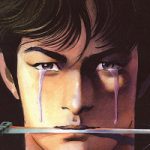Barefoot Gen (Hadashi no Gen)
Regions: Japan

Barefoot Gen is a semi-autobiographical manga series penned by Keiji Nakazawa (1939-2012), about a young survivor of the atomic bombing in Hiroshima, partly based on Nakazawa’s own experiences in the bombing.
Gen Nakaoka lives in Hiroshima together with his family. When his father openly protests against the militaristic regime and war, the whole family is shunned by their neighbours and the children are bullied mercilessly at school. On August 6th, the Allied forces drop the atomic bomb on the city, killing tens of thousands of people. Gen directly witnesses the death of his father and two siblings, who die trapped in their burning home. Only his pregnant mother Kimie survives, and the shock forces her into premature labour – in midst of all the death and devastation, Gen’s sister Tomoko is born. Together with an orphaned boy named Ryūta, the surviving members of the Nakaoka family – joined by two of Gen’s older brothers, who were outside Hiroshima at the time the bombing – travel through the ruins of Hiroshima in search of shelter and food. They receive little help from other people who escaped the bombing, and also harbour the fear of catching radiation sickness from the survivors. After months of suffering, Tomoko dies of malnutrition. While greatly saddened by his little sister’s death, Gen vows to continue living and taking care of his mother, who begins showing symptoms of radiation poisoning. Despite his efforts, Kimie dies three years after the bombing, and Gen moves alone to Tokyo.
Barefoot Gen was not the first manga written about the tragedy of the atomic bomb, but it is very likely the most famous one. The story was first published in 1973, in one of the most popular comics magazines Shōnen Jump, despite the fact that its strong political message and very gory elements made it a rather non-typical shōnen manga of that time. While it enjoyed a modest success, Barefoot Gen was discontinued after two years when Nakazawa refused to compromise the quality of the story by shortening the page count requested by the publisher. However, finding another publisher turned out to be very tricky, as many felt uncomfortable publishing such a controversial story, especially one with such harsh criticism towards the Emperor, whom Nakazawa deemed responsible for WWII (Itō, Omote 2006, 30-33). In the end, Gen continued to be serialized outside mainstream magazines, and was published in a left-wing magazine Citizen (Shimin) in 1975, and after its discontinuation in 1976, it moved to Cultural Review (Bunka hyōron) and then to Educational Review (Kyōiku hyōron), where it finally came to its end in 1986. Meanwhile the series was also published separately in a compilation volume form and became a bestseller; later it was also adapted into anime, novel and a live-action movie. In 1976, “Project Gen” was founded in order to spread awareness of the Hiroshima tragedy. Barefoot Gen then became the first manga series to be translated into English, as well as several other languages. (ibid, 41-42)
— Anna Krivankova
See Also: Keiji Nakazawa
Further Reading
- Itō, Yū & Omote, Tomoyuki. 2006. Barefoot Gen in Japan: An Attempt at Media History. In: Reading Manga: Local and Global Perceptions of Japanese Comics. Jaqueline Berndt and Steffi Richter (ed.). Leipzig: Leipziger Universitätsverlag
- Sabin, Roger.2006.Barefoot Gen in the US and UK: Activist Comics, Graphic Novel Manga.In: Reading Manga: Local and Global Perceptions of Japanese Comics. Jaqueline Berndt and Steffi Richter (ed.). Leipzig: Leipziger Universitätsverlag
- Schodt, Frederik L., and Osamu Tezuka. 1988. Manga! Manga!: The World of Japanese Comics ; Includes 96 Pages from Osamu Tezuka’s “Phoenix”, Reiji Matsumoto’s “Ghost Warrior”, Riyoko Ikeda’s “The Rose of Versailles”, Keiji Nakazawa’s “Barefoot Gen”. Tokyo, New York: Kodansha Internat.


